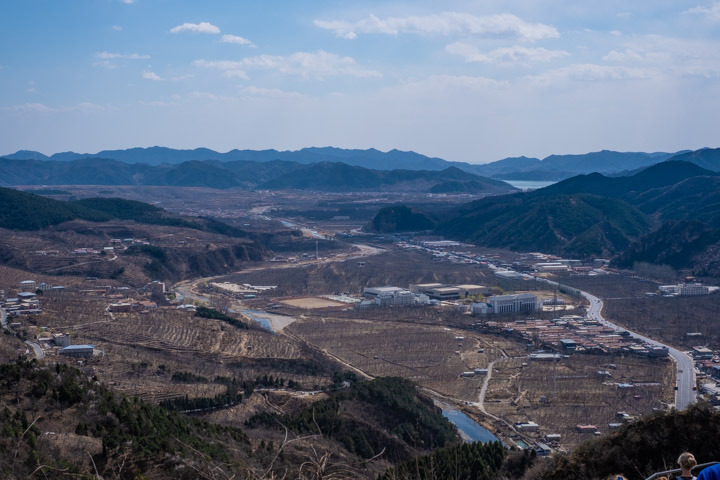
It’s a chunk of China west and south of Beijing, extending to the sea, with a mere fifteen or so million or so people. It was where our walking-the-Wall sequence ended up, specifically at 黄崖关 (Huangyaguan). The wall there was OK, but there was an attached museum I really liked, and also the Eastern Qing Tombs, which are highly photogenic and full of stories. Here’s a view out over Huangyaguan from up on the Wall.
[This is part of The Surface of China series.]
If you make it to Huangyaguan, don’t spend your whole time up on the wall, leave an hour or two for the Huangyaguan Great Wall Museum, which seems not to have a Web presence. It’s big, mostly open to the sky, and serene. Of the many exhibits, I’ll offer a sample from the “Garden of Longevity”. It features ten thousand character forms which can be read as some variation on “Long Life”, in a nice cloister around a serene courtyard.
Now, here’s a sidelight. We had a pretty good card-playing session going after dinner, and one of our party slunk off and came back with some liquid refreshments; sharing out a couple of these greatly increased the liquidity and joviality of the card game. I have no idea what it is.
The Tombs · I’m talking about the Eastern Qing Tombs; as Wikipedia says “the largest, most complete, and best preserved extant mausoleum complex in China”. They’re big all right, I suppose you could walk around them in a day but you’d be exhausted. We put in several hours and only saw a few highlights. Here’s the processional way leading in, flanked by lines of stone animals. The animals come in pairs, for each species on is standing and another resting, to show that they guarded the tombs 24/7/365.
The variety and beauty of carved stonework is remarkable, and it’s not just sitting there, it’s actively maintained.
We spent a lot of time at the tomb of the Qinlong Emperor (1711-99), one of the most successful Chinese rulers ever, said also to have been a reasonable human being. You can go underground to the actual burial chambers, whose walls are covered with really remarkable carving.
The inscription is in Tibetan. I asked why and our local guide (a required hire, and only adequate) said “Because he was Buddhist and there are Buddhists in Tibet.” Um, OK.
There were a few merchants scattered among the tombs. This guy’s dried fruit looked excellent and I bought some, which he weighed out with charming analog technology.
The dried fruit was shockingly good. I bought a lot and we brought some home (a little worried that might have been illegal); its flavor hotly intense in the mouth.
This merchant had a huge golden throne, you could dress up as Emperor and Empress and get your picture taken. This guy was getting ready for his photo and was unhappy at me snapping his picture. If the real emperor got an expression like that on his face, it’d probably be curtains for you.
The Dowager Empress · The Qing dynasty was also called Manchu, for Manchurian, and their existence represents a failure of the Great Wall. Eventually the people on the other side of it came south and became China’s rulers. Theirs was the last dynasty, extending into the 20th Century and eventually ended by the Chinese Revolution.
During its fading years, the most important character was the Dowager Empress Cixi; that link is to her Wikipedia entry, which has a pretty good photo portrait. I think she was what today we would call pretty badass, and via a series of regencies was the effective ruler of China from 1861 until her death in 1908. She was from a family of the minor aristocracy , was brought into the ruling family as a concubine, and found her way to the top.
Her tomb is generally great. Here are a couple of pictures of a little shrine that has a wonderful statue of a turtle/dragon carrying a plinth with an inscription in Chinese, Manchurian, and Mongolian.
And here’s her burial site, with some of the wood of her coffin showing. It wasn’t a happy period for China, with the imperial regime declining, partly under pressure from the British and other colonial land-grabbers. I’d heard of the Dowager Empress, but what I hadn’t realized that she was a fabulously accomplished artist; here are painting and calligraphy. I think I liked them better than any Chinese art that I’ve seen. Having said that, I’ve mostly seen such art reproduced in books or on my screen; being face-to-face with these big graphics is really hard-hitting.
It’s a great tourist site and I recommend it. Everywhere you look is a treat for the eyes.
Then we drove a couple of hours back to the haze and hustle of Beijing.